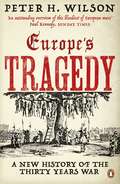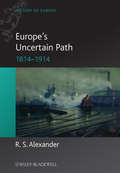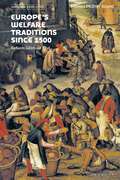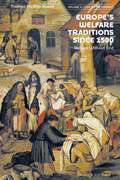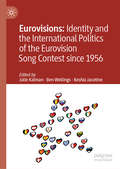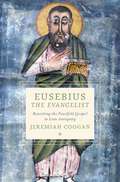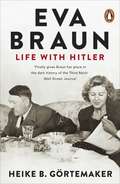- Table View
- List View
Europe's Third World: The European Periphery in the Interwar Years
by Derek H. AldcroftEconomic historians have perennially addressed the intriguing question of comparative development, asking why some countries develop much faster and further than others. Focusing primarily on Europe between 1914 and 1939, this present volume explores the development of thirteen countries that could be said to be categorised as economically backward during this period: Albania, Bulgaria, Estonia, Greece, Hungary, Latvia, Lithuania, Poland, Portugal, Romania, Spain, Turkey and Yugoslavia. These countries are linked, not only in being geographically on Europe's periphery, but all shared high agrarian components and income levels much lower than those enjoyed in western European countries. The study shows that by 1918 many of these countries had structural characteristics which either relegated them to a low level of development or reflected their economic backwardness, characteristics that were not helped by the hostile economic climate of the interwar period. It explores, region by region, how their progress was checked by war and depression, and how the effects of political and social factors could also be a major impediment to sustained progress and modernisation. For example, in many cases political corruption and instability, deficient administrations, ethnic and religious diversity, agrarian structures and backwardness, population pressures, as well as international friction, were retarding factors. In all this study offers a fascinating insight into many areas of Europe that are often ignored by economists and historians. It demonstrates that these countries were by no means a lost cause, and that their post-war performances show the latent economic potential that most harboured. By providing an insight into the development of Europe's 'periphery' a much more rounded and complete picture of the continent as a whole is achieved.
Europe's Third World: The European Periphery in the Interwar Years
by Derek H. AldcroftEconomic historians have perennially addressed the intriguing question of comparative development, asking why some countries develop much faster and further than others. Focusing primarily on Europe between 1914 and 1939, this present volume explores the development of thirteen countries that could be said to be categorised as economically backward during this period: Albania, Bulgaria, Estonia, Greece, Hungary, Latvia, Lithuania, Poland, Portugal, Romania, Spain, Turkey and Yugoslavia. These countries are linked, not only in being geographically on Europe's periphery, but all shared high agrarian components and income levels much lower than those enjoyed in western European countries. The study shows that by 1918 many of these countries had structural characteristics which either relegated them to a low level of development or reflected their economic backwardness, characteristics that were not helped by the hostile economic climate of the interwar period. It explores, region by region, how their progress was checked by war and depression, and how the effects of political and social factors could also be a major impediment to sustained progress and modernisation. For example, in many cases political corruption and instability, deficient administrations, ethnic and religious diversity, agrarian structures and backwardness, population pressures, as well as international friction, were retarding factors. In all this study offers a fascinating insight into many areas of Europe that are often ignored by economists and historians. It demonstrates that these countries were by no means a lost cause, and that their post-war performances show the latent economic potential that most harboured. By providing an insight into the development of Europe's 'periphery' a much more rounded and complete picture of the continent as a whole is achieved.
Europe's Tragedy: A New History of the Thirty Years War
by Peter H. WilsonThe horrific series of conflicts known as the Thirty Years War (1618-48) tore the heart out of Europe, killing perhaps a quarter of all Germans and laying waste to whole areas of Central Europe to such a degree that many towns and regions never recovered. All the major European powers apart from Russia were heavily involved and, while each country started out with rational war aims, the fighting rapidly spiralled out of control, with great battles giving way to marauding bands of starving soldiers spreading plague and murder. The war was both a religious and a political one and it was this tangle of motives that made it impossible to stop. Whether motivated by idealism or cynicism, everyone drawn into the conflict was destroyed by it. At its end a recognizably modern Europe had been created but at a terrible price.Peter Wilson's book is a major work, the first new history of the war in a generation, and a fascinating, brilliantly written attempt to explain a compelling series of events. Wilson's great strength is in allowing the reader to understand the tragedy of mixed motives that allowed rulers to gamble their countries' future with such horrifying results. The principal actors in the drama (Wallenstein, Ferdinand II, Gustavus Adolphus, Richelieu) are all here, but so is the experience of the ordinary soldiers and civilians, desperately trying to stay alive under impossible circumstances.The extraordinary narrative of the war haunted Europe's leaders into the twentieth century (comparisons with 1939-45 were entirely appropriate) and modern Europe cannot be understood without reference to this dreadful conflict.
Europe's Troubled Peace: 1945 to the Present (Blackwell History of Europe #15)
by Tom BuchananThis revised second edition now extends to the end of the first decade of the twenty-first century, covering the financial crisis and the related crisis in European integration, the impact of the “War on Terror” on Europe, and the redefinition of Europe following EU enlargement. Thoroughly revised and expanded, this integrated history of Europe now covers the end of the Second World War up to the end of the first decade of the twenty-first century Includes new sections on immigration and ethnicity in Europe after the Cold War, and the role of historical memory in contemporary Europe A final new chapter assesses the role of Europe within the wider world of the twenty-first century, the financial crisis and the related crisis in European integration, the impact of the “War on Terror” on Europe, and the redefinition of Europe following EU enlargement Covers the history of central and eastern Europe in depth, as well as that of Western Europe Discusses in detail the impact of the Cold War across the continent
Europe's Uncertain Path 1814-1914: State Formation and Civil Society (Blackwell History of Europe #12)
by R. S. AlexanderEurope’s Uncertain Path is an introduction to Europe’s turbulent history from 1814 to 1914. It presents a clear narrative of the major political events, set against the backdrop of social, economic, and cultural change. An introduction to Europe’s turbulent history from 1814 to 1914 Provides students with a solid grounding in the main political events and social changes of the period Explains the causes and outcomes of major events: the effect of the emergence of mass politics; the evolution of political ideologies; and the link between foreign and domestic policy Offers balanced coverage of Eastern, Western, and Central Europe Illustrations, maps, and figures enhance student understanding
Europe's Uncertain Path 1814-1914: State Formation and Civil Society (Blackwell History of Europe #11)
by R. S. AlexanderEurope’s Uncertain Path is an introduction to Europe’s turbulent history from 1814 to 1914. It presents a clear narrative of the major political events, set against the backdrop of social, economic, and cultural change. An introduction to Europe’s turbulent history from 1814 to 1914 Provides students with a solid grounding in the main political events and social changes of the period Explains the causes and outcomes of major events: the effect of the emergence of mass politics; the evolution of political ideologies; and the link between foreign and domestic policy Offers balanced coverage of Eastern, Western, and Central Europe Illustrations, maps, and figures enhance student understanding
Europe's Utopias of Peace: 1815, 1919, 1951 (Europe’s Legacy in the Modern World)
by Bo StråthEurope's Utopias of Peace explores attempts to create a lasting European peace in the aftermath of the Napoleonic wars and the two world wars. The book charts the 250 year cycle of violent European conflicts followed by new utopian formulations for peace. The utopian illusion was that future was predictable and rules could prescribe behaviour in conflicts to come.Bo Stråth examines the reiterative bicentenary cycle since 1815, where each new postwar period built on a design for a project for European unification. He sets out the key historical events and the continuous struggle with nationalism, linking them to legal, political and economic thought. Biographical sketches of the most prominent thinkers and actors provide the human element to this narrative.Europe's Utopias of Peace presents a new perspective on the ideological, legal, economic and intellectual conditions that shaped Europe since the 19th century and presents this in a global context. It challenges the conventional narrative on Europe's past as a progressive enlightenment heritage, highlighting the ambiguities of the legacies that pervade the institutional structures of contemporary Europe. Its long-term historical perspective will be invaluable for students of contemporary Europe or modern European history.
Europe's Utopias of Peace: 1815, 1919, 1951 (Europe’s Legacy in the Modern World)
by Bo StråthEurope's Utopias of Peace explores attempts to create a lasting European peace in the aftermath of the Napoleonic wars and the two world wars. The book charts the 250 year cycle of violent European conflicts followed by new utopian formulations for peace. The utopian illusion was that future was predictable and rules could prescribe behaviour in conflicts to come.Bo Stråth examines the reiterative bicentenary cycle since 1815, where each new postwar period built on a design for a project for European unification. He sets out the key historical events and the continuous struggle with nationalism, linking them to legal, political and economic thought. Biographical sketches of the most prominent thinkers and actors provide the human element to this narrative.Europe's Utopias of Peace presents a new perspective on the ideological, legal, economic and intellectual conditions that shaped Europe since the 19th century and presents this in a global context. It challenges the conventional narrative on Europe's past as a progressive enlightenment heritage, highlighting the ambiguities of the legacies that pervade the institutional structures of contemporary Europe. Its long-term historical perspective will be invaluable for students of contemporary Europe or modern European history.
Europe’s Welfare Traditions Since 1500, Volume 1: 1500-1700
by Thomas McStay AdamsTracing the interwoven traditions of modern welfare states in Europe over five centuries, Thomas McStay Adams explores social welfare from Portugal, France, and Italy to Britain, Belgium and Germany. He shows that the provision of assistance to those in need has faced recognizably similar challenges from the 16th century through to the present: how to allocate aid equitably (and with dignity); how to give support without undermining autonomy (and motivation); and how to balance private and public spheres of action and responsibility.Across two authoritative volumes, Adams reveals how social welfare administrators, critics, and improvers have engaged in a constant exchange of models and experience locally and across Europe. The narrative begins with the founding of the Casa da Misericordia of Lisbon in 1498, a model replicated throughout Portugal and its empire, and ends with the relaunch of a social agenda for the European Union at the meeting of the Council of Europe in Lisbon in 2000.Volume 1, which focuses on the period from 1500 to 1700, discusses the concepts of 'welfare' and 'tradition'. It looks at how 16th-century humanists joined with merchants and lawyers to renew traditional charity in distinctly modern forms, and how the discipline of religious reform affected the exercise of political authority and the promotion of economic productivity.Volume 2 examines 18th-century bienfaisance which secularized a Christian humanist notion of beneficence, producing new and sharply contested assertions of social citizenship. It goes on to consider how national struggles to establish comprehensive welfare states since the second half of the 19th century built on the power of the vote as politicians, pushed by activists and advised by experts, appealed to a growing class of industrial workers. Lastly, it looks at how 20th-century welfare states addressed aspirations for social citizenship while the institutional framework for European economic cooperation came to fruition
Europe’s Welfare Traditions Since 1500, Volume 1: 1500-1700
by Thomas McStay AdamsTracing the interwoven traditions of modern welfare states in Europe over five centuries, Thomas McStay Adams explores social welfare from Portugal, France, and Italy to Britain, Belgium and Germany. He shows that the provision of assistance to those in need has faced recognizably similar challenges from the 16th century through to the present: how to allocate aid equitably (and with dignity); how to give support without undermining autonomy (and motivation); and how to balance private and public spheres of action and responsibility.Across two authoritative volumes, Adams reveals how social welfare administrators, critics, and improvers have engaged in a constant exchange of models and experience locally and across Europe. The narrative begins with the founding of the Casa da Misericordia of Lisbon in 1498, a model replicated throughout Portugal and its empire, and ends with the relaunch of a social agenda for the European Union at the meeting of the Council of Europe in Lisbon in 2000.Volume 1, which focuses on the period from 1500 to 1700, discusses the concepts of 'welfare' and 'tradition'. It looks at how 16th-century humanists joined with merchants and lawyers to renew traditional charity in distinctly modern forms, and how the discipline of religious reform affected the exercise of political authority and the promotion of economic productivity.Volume 2 examines 18th-century bienfaisance which secularized a Christian humanist notion of beneficence, producing new and sharply contested assertions of social citizenship. It goes on to consider how national struggles to establish comprehensive welfare states since the second half of the 19th century built on the power of the vote as politicians, pushed by activists and advised by experts, appealed to a growing class of industrial workers. Lastly, it looks at how 20th-century welfare states addressed aspirations for social citizenship while the institutional framework for European economic cooperation came to fruition
Europe’s Welfare Traditions Since 1500, Volume 2: 1700-2000
by Thomas McStay AdamsTracing the interwoven traditions of modern welfare states in Europe over five centuries, Thomas McStay Adams explores social welfare from Portugal, France, and Italy to Britain, Belgium and Germany. He shows that the provision of assistance to those in need has faced recognizably similar challenges from the 16th century through to the present: how to allocate aid equitably (and with dignity); how to give support without undermining autonomy (and motivation); and how to balance private and public spheres of action and responsibility.Across two authoritative volumes, Adams reveals how social welfare administrators, critics, and improvers have engaged in a constant exchange of models and experience locally and across Europe. The narrative begins with the founding of the Casa da Misericordia of Lisbon in 1498, a model replicated throughout Portugal and its empire, and ends with the relaunch of a social agenda for the European Union at the meeting of the Council of Europe in Lisbon in 2000.Volume 1, which focuses on the period from 1500 to 1700, discusses the concepts of 'welfare' and 'tradition'. It looks at how 16th-century humanists joined with merchants and lawyers to renew traditional charity in distinctly modern forms, and how the discipline of religious reform affected the exercise of political authority and the promotion of economic productivity.Volume 2 examines 18th-century bienfaisance which secularized a Christian humanist notion of beneficence, producing new and sharply contested assertions of social citizenship. It goes on to consider how national struggles to establish comprehensive welfare states since the second half of the 19th century built on the power of the vote as politicians, pushed by activists and advised by experts, appealed to a growing class of industrial workers. Lastly, it looks at how 20th-century welfare states addressed aspirations for social citizenship while the institutional framework for European economic cooperation came to fruition
Europe’s Welfare Traditions Since 1500, Volume 2: 1700-2000
by Thomas McStay AdamsTracing the interwoven traditions of modern welfare states in Europe over five centuries, Thomas McStay Adams explores social welfare from Portugal, France, and Italy to Britain, Belgium and Germany. He shows that the provision of assistance to those in need has faced recognizably similar challenges from the 16th century through to the present: how to allocate aid equitably (and with dignity); how to give support without undermining autonomy (and motivation); and how to balance private and public spheres of action and responsibility.Across two authoritative volumes, Adams reveals how social welfare administrators, critics, and improvers have engaged in a constant exchange of models and experience locally and across Europe. The narrative begins with the founding of the Casa da Misericordia of Lisbon in 1498, a model replicated throughout Portugal and its empire, and ends with the relaunch of a social agenda for the European Union at the meeting of the Council of Europe in Lisbon in 2000.Volume 1, which focuses on the period from 1500 to 1700, discusses the concepts of 'welfare' and 'tradition'. It looks at how 16th-century humanists joined with merchants and lawyers to renew traditional charity in distinctly modern forms, and how the discipline of religious reform affected the exercise of political authority and the promotion of economic productivity.Volume 2 examines 18th-century bienfaisance which secularized a Christian humanist notion of beneficence, producing new and sharply contested assertions of social citizenship. It goes on to consider how national struggles to establish comprehensive welfare states since the second half of the 19th century built on the power of the vote as politicians, pushed by activists and advised by experts, appealed to a growing class of industrial workers. Lastly, it looks at how 20th-century welfare states addressed aspirations for social citizenship while the institutional framework for European economic cooperation came to fruition
The Eurosceptical Reader
by M. HolmesThe Eurosceptical Reader is the authoritative guide to the compelling arguments against European integration. The book sets out to dispel the myth which has grown up over the past thirty years that Britain's Eurosceptics are backward-looking, nationalistic, even xenophobic 'Little Englanders'. In reality, as this collection of articles and speeches illustrates, the Eurosceptical case has been anything other than introverted and obsessed with the past. Eurosceptics have always looked to the wider world beyond Europe not to a nostalgic British isolation. Whether from within the two main parties or from academia and journalism, the Eurosceptical case has become both intellectually powerful and politically persuasive. The all-star cast provides contemporary analysis to supplement classic contributions from Hugh Gaitskell, Margaret Thatcher, Enoch Powell, Tony Benn and others.
Eurovision!: A History of Modern Europe Through the World's Greatest Song Contest
by Chris WestAn entertaining look at the changing face of the Eurovision Song Contest and the political and cultural influences behind its kitsch and glitzy façade.Do you think the world of the Eurovision Song Contest, with its crazy props, even crazier dancers, and crazier still songs has nothing to do with serious European politics? Think again. The contest has been a mirror for cultural, social, and political developments in Europe ever since its inauguration, when an audience in dinner jackets and ball gowns politely applauded each song. It has been a voice of rebellion across the Iron Curtain, an inspiration for new European nations in the 1990s and 2000s, the voice of liberation for both sexual and regional minorities. It even once triggered a national revolution.Eurovision! charts both the history of Europe and the history of the Eurovision Song Contest over the last six decades, and shows how seamlessly they interlink — and what an amazing journey it has been.
Eurovisions: Identity and the International Politics of the Eurovision Song Contest since 1956
by Julie Kalman Ben Wellings Keshia JacotineThis book uses the Eurovision Song Contest (ESC), as an analytical entry point to understand and illuminate post-War Europe and the drive to create an identity that can legitimise the European project in its broadest sense. The ESC presents an idealised vision of Europe, and this has long existed in a strained relationship with reality. While the trajectory of post-war European integration is a high-profile topic, we believe that the ESC offers a unique and innovative way to think about the role of culture in the history of post-War European integration and tensions between the ideal and reality of European unity. Through the series of case studies that make up the chapters in this book, analysis brings these interlinked tensions to light, exploring the roles of culture and identity, alongside and a productive conversation with the political and economic projects of post-war European integration.
Eurydice and the Birth of Macedonian Power (WOMEN IN ANTIQUITY)
by Elizabeth Donnelly CarneyEurydice (c.410-340s BCE) played a significant part in the public life of ancient Macedonia, the first royal Macedonian woman known to have done so, though hardly the last. She was the wife of Amyntas III, the mother of Philip II (and two other short-lived kings of Macedonia), and grandmother of Alexander the Great. Her career marks a turning point in the role of royal women in Macedonian monarchy, one that coincides with the emergence of Macedonia as a great power in the Hellenic world. This study examines the nature of her public role as well as the factors that contributed to its expansion and to the expanding power of Macedonia. Some ancient sources picture Eurydice as a murderous adulteress willing to attempt the elimination of her husband and her three sons for the sake of her lover, whereas others portray her as a doting and heroic mother whose actions led to the preservation of the throne for her sons. While the latter view is likely closer to historical reality, both the "good" and "bad" Eurydice traditions portray her as the leader of a faction, an active figure at court and in international affairs. Eurydice's activity, sinister or not, directly related to the fact that, at the time of her husband's death, the eldest of her three sons was barely old enough to rule and enemies, foreign and domestic, threatened. Two of Eurydice's sons were assassinated and the third died in battle. Eurydice functioned not only a succession advocate for her sons but she also played a part in the construction of the public image of the dynasty, both because of her own actions and because of the ways in which her son Philip II chose to depict and commemorate her. Drawing on recent archaeological discoveries and all surviving literary evidence, this portrait illuminates the life of a remarkable queen at the birth of a celebrated epoch.
EURYDICE & BIRTH OF MACEDON POWER WIA C (WOMEN IN ANTIQUITY)
by Elizabeth Donnelly CarneyEurydice (c.410-340s BCE) played a significant part in the public life of ancient Macedonia, the first royal Macedonian woman known to have done so, though hardly the last. She was the wife of Amyntas III, the mother of Philip II (and two other short-lived kings of Macedonia), and grandmother of Alexander the Great. Her career marks a turning point in the role of royal women in Macedonian monarchy, one that coincides with the emergence of Macedonia as a great power in the Hellenic world. This study examines the nature of her public role as well as the factors that contributed to its expansion and to the expanding power of Macedonia. Some ancient sources picture Eurydice as a murderous adulteress willing to attempt the elimination of her husband and her three sons for the sake of her lover, whereas others portray her as a doting and heroic mother whose actions led to the preservation of the throne for her sons. While the latter view is likely closer to historical reality, both the "good" and "bad" Eurydice traditions portray her as the leader of a faction, an active figure at court and in international affairs. Eurydice's activity, sinister or not, directly related to the fact that, at the time of her husband's death, the eldest of her three sons was barely old enough to rule and enemies, foreign and domestic, threatened. Two of Eurydice's sons were assassinated and the third died in battle. Eurydice functioned not only a succession advocate for her sons but she also played a part in the construction of the public image of the dynasty, both because of her own actions and because of the ways in which her son Philip II chose to depict and commemorate her. Drawing on recent archaeological discoveries and all surviving literary evidence, this portrait illuminates the life of a remarkable queen at the birth of a celebrated epoch.
Eurythmy and Rudolf Steiner: Origins and Development 1912-39
by Tatiana KisseleffIn the autumn of 1912, Rudolf Steiner presented the first eurythmy performance. It marked the revival, in modern form, of the sacred art of dance, which had been used in the ancient Mysteries to express the movements of the stars and the planets. In the years that followed, Steiner and his wife, Marie von Sivers, developed eurythmy further, broadening it beyond the artistic to encompass healing and educational elements as well.One of the pioneers of this new form of movement was the Russian anthroposophist Tatiana Kisseleff, who became a student of Steiner's and later a celebrated eurythmy teache.In this remarkable book, available for the first time in English, Kisseleff describes the spiritual foundations of eurythmy as they were explored in Steiner's lectures and recounts the instruction she received from him. This is both an eyewitness account of the origins of eurythmy and a record of a deeply personal journey of one person's efforts to master it. The book is illustrated throughout with photographs, drawings, facsimile reproductions from notebooks and posters advertising early eurythmy performances, alongside accounts of performances of various pieces including Shakespeare's The Tempest, Goethe's Faust, and Rudolf Steiner's own Mystery Dramas. This is a fascinating account for eurythmists and anyone who wants to delve more deeply into eurythmy's history and development.
Eusebius (Understanding Classics)
by Aaron P. JohnsonEusebius of Caesarea (263-339 CE) is one of the most important intellectuals whose writings survive from late antiquity. His texts made lasting and wide-ranging contributions, from history-writing and apologetics to biblical commentary and Christian oratory. He was a master of many of the literary and scholarly traditions of the Greek heritage. Yet he left none of these traditions unaltered as he made brilliant and original experiments in the many genres he explored. Aaron P Johnson offers a lively introduction to Eusebius' chief oeuvre while also discussing recent scholarship on this foundational early Christian writer. Placing Eusebius in the context of his age the author provides a full account his life, including the period when Eusebius controversially sought to assist the heretic Arius. He then discusses the major writings: apologetic treatises; the pedagogical and exegetical works; the historical texts; the anti-Marcellan theological discourses; and expositions directly connected to the Emperor Constantine.
Eusebius the Evangelist: Rewriting the Fourfold Gospel in Late Antiquity (Cultures of Reading in the Ancient Mediterranean)
by Jeremiah CooganEusebius the Evangelist analyzes Eusebius of Caesarea's fourth-century reconfiguration of the Gospels as a window into broader questions of technology and textuality in the ancient Mediterranean. The four Gospels of the New Testament (Matthew, Mark, Luke, and John) share language, narratives, and ideas, yet they also differ in structure and detail. The sophisticated system through which Eusebius organized this intricate web of textual relationships is known as the Eusebian apparatus. Eusebius' editorial interventioninvolving tables, sectioning, and tables of contentsparticipates in a broader late ancient transformation in reading and knowledge. To illuminate Eusebius' innovative use of textual technologies, the study juxtaposes diverse ancient disciplinesincluding chronography, astronomy, geography, medicine, philosophy, and textual criticismwith a wide range of early Christian sources, attending to neglected evidence from material texts and technical literature. These varied phenomena reveal how Eusebius' fourfold Gospel worked in the hands of readers. Eusebius' creative juxtapositions of Gospel material had an enduring impact on Gospel reading. Not only did Eusebius continue earlier trajectories of Gospel writing, but his apparatus continued to generate new possibilities in the hands of readers. For more than a millennium, in over a dozen languages and in thousands of manuscripts, Eusebius' invention transformed readers' encounters with Gospel text on the page. By employing emerging textual technologies, Eusebius created new possibilities of reading, thereby rewriting the fourfold Gospel in a significant and durable way.
Eusebius the Evangelist: Rewriting the Fourfold Gospel in Late Antiquity (Cultures of Reading in the Ancient Mediterranean)
by Jeremiah CooganEusebius the Evangelist analyzes Eusebius of Caesarea's fourth-century reconfiguration of the Gospels as a window into broader questions of technology and textuality in the ancient Mediterranean. The four Gospels of the New Testament (Matthew, Mark, Luke, and John) share language, narratives, and ideas, yet they also differ in structure and detail. The sophisticated system through which Eusebius organized this intricate web of textual relationships is known as the Eusebian apparatus. Eusebius' editorial interventioninvolving tables, sectioning, and tables of contentsparticipates in a broader late ancient transformation in reading and knowledge. To illuminate Eusebius' innovative use of textual technologies, the study juxtaposes diverse ancient disciplinesincluding chronography, astronomy, geography, medicine, philosophy, and textual criticismwith a wide range of early Christian sources, attending to neglected evidence from material texts and technical literature. These varied phenomena reveal how Eusebius' fourfold Gospel worked in the hands of readers. Eusebius' creative juxtapositions of Gospel material had an enduring impact on Gospel reading. Not only did Eusebius continue earlier trajectories of Gospel writing, but his apparatus continued to generate new possibilities in the hands of readers. For more than a millennium, in over a dozen languages and in thousands of manuscripts, Eusebius' invention transformed readers' encounters with Gospel text on the page. By employing emerging textual technologies, Eusebius created new possibilities of reading, thereby rewriting the fourfold Gospel in a significant and durable way.
Euuugh! Eyeball Stew!: Iggy the Urk: Book 3
by Alan MacDonald Mark BeechIggy discovers a young member of the Henna tribe lost in the jungle (Henna, so-named for their fiery red hair and penchant for covering their faces in mud). The girl is wearing some rare and precious firestones, which mesmerise the Urks, especially Borg, who devises a new and devious plot to become Chief Urk. Iggy must embark on a dangerous journey to return the Henna girl safely to her tribe in the Cloud Mountains. But when he gets there, the welcome is not exactly what he had in mind.Time for a very cunning plan.
Euvitalistische Biologie: Zur Grundlegung der Kultur
by Karl Camillo SchneiderDieser Buchtitel ist Teil des Digitalisierungsprojekts Springer Book Archives mit Publikationen, die seit den Anfängen des Verlags von 1842 erschienen sind. Der Verlag stellt mit diesem Archiv Quellen für die historische wie auch die disziplingeschichtliche Forschung zur Verfügung, die jeweils im historischen Kontext betrachtet werden müssen. Dieser Titel erschien in der Zeit vor 1945 und wird daher in seiner zeittypischen politisch-ideologischen Ausrichtung vom Verlag nicht beworben.
Eva Braun: Life With Hitler
by Heike B. Gortemaker Damion SearlsDAILY TELEGRAPH BOOKS OF THE YEAR and BBC HISTORY MAGAZINE BOOK CLUB title'I want to be a beautiful corpse, I will take poison' Eva Braun, 1945Eva Braun and Adolf Hitler were together for fourteen years, a relationship that ended only with their marriage and double suicide in Berlin. Braun was obsessed with sport, fashion, photography and films, and seems to have had no real interest in politics. She and Hitler were unmarried and they had no children. And so, at the heart of the Nazi regime there was an odd paradox: the leader of a ferocious dictatorship, himself obsessed with imposing an idea of the 'German family' on an entire nation, who chose to spend much of his adult life with a woman 23 years younger than himself in a way that was unideological and bohemian.So who was Eva Braun? Heike Görtemaker's highly praised new book is the first to take Braun's role in the Nazi hierarchy seriously. It uses her to throw fascinating light on a regime that prided itself on its harsh, coherent and unsentimental ideology, but which was in practice a chaos of competing individuals fighting for space around the overwhelmingly dominant figure of Hitler. Braun had a special place 'at court'. She was both marginal and exceptional: a more powerful figure than 'the First Ladies of the Third Reich' such as Magda Goebbels and Margarete Speer, but someone who almost never chose to use that power.Braun's life tells us a huge amount about a particular, catastrophic era in German history, both in her role as Hitler's companion and as the hostess at Nazi social events at the Berghof. Heike Görtemaker's book allows Braun to step out as much as possible from the shadows and fully inhabit her strange role at the heart of a terrible regime.
Eva Gore-Booth: An image of such politics
by Sonja TiernanThis is the first dedicated biography of the extraordinary Irish woman, Eva Gore-Booth. Gore-Booth rejected her aristocratic heritage choosing to live and work amongst the poorest classes in industrial Manchester. Her work on behalf of barmaids, circus acrobats, flower sellers and pit-brow lasses is traced in this book. During one impressive campaign Gore-Booth orchestrated the defeat of Winston Churchill. Gore-Booth published volumes of poetry, philosophical prose and plays, becoming a respected and prolific author of her time and part of W.B. Yeats’ literary circle. The story of Gore-Booth’s life is captivating. Her close bond with her sister, an iconic Irish nationalist, provides a new insight into Countess Markievicz’s personal life. Gore-Booth’s life story vividly traces her experiences of issues such as militant pacifism during the Great War, the case for the reprieve of Roger Casement’s death sentence, sexual equality in the workplace and the struggle for Irish independence.

